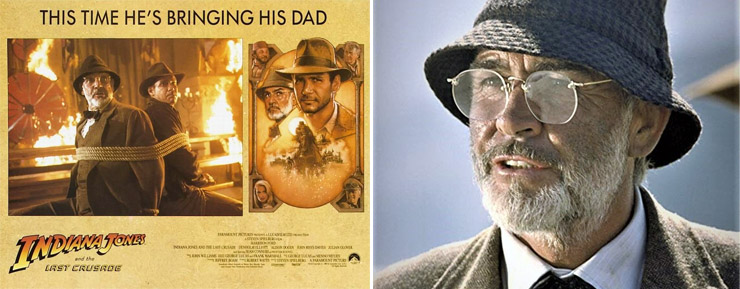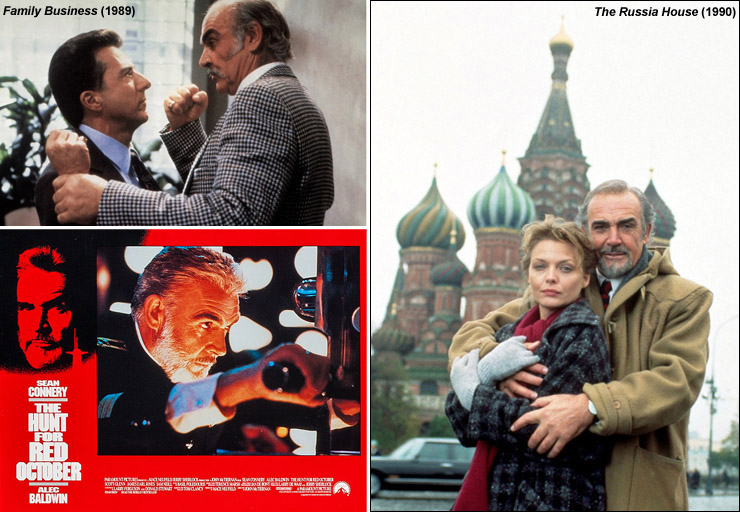JAMES BOND
|
||
|
||
JAMES BOND
|
||
|
||
|
||||
|
Part 6: The great
comeback |
||||
|
|
||||
|
Following his negative experiences with American studio backed films in the early 1980s, Sean Connery next appeared in a starring role in a European made film which would earn him a BAFTA award as Best Actor in 1988. The Name Of The Rose (1986) directed by Jean-Jacques Annaud, saw Connery playing William of Baskerville opposite a young Christian Slater, in a film which many thought unfilmable. The Name Of The Rose was based on the 1980 novel by Umberto Eco, and tells the story of a Franciscan Friar who is called upon to solve a series of murders in a Benedictine Abbey in Northern Italy in 1327. Although poorly received in the US, the film was surprisingly a massive international hit, and gave the 55-year old Connery the best role he had in years. The wonderfully authentic production co-starred F. Murray Abraham, Michael Lonsdale and Ron Perlman. The US 1-sheet poster had painted ‘hero-style’ artwork by the celebrated Drew Struzan (1947-2025), which mis-represented the dark grotesque atmosphere of the film; whereas the UK and European posters opted for a simple black & white close up of Connery's face. The Name Of The Rose ended up grossing $77-million worldwide - ten times what it had cost to produce, with Connery finally receiving recognition for his acting in a role far removed from that of James Bond. |
||||
 |
||||
|
Sean Connery followed up his BAFTA award-winning performance by appearing in The Untouchables in 1987 which would then earn him an Oscar and a Golden Globe award as Best Supporting Actor. Playing veteran Irish-American police officer James ‘Jimmy’ Malone opposite Kevin Costner as Eliot Ness, Connery once again brings gravitas to a role where his whole screen persona is as important as his acting. Directed by Brian De Palma from a screenplay by David Mamet, and co-starring Robert De Niro in a scenery-chewing performance as gangster Al Capone, the film was a superb high-profile thriller winning many other awards in addition to Connery's Oscar. Many thought the award was a consolation prize for years of Academy indifference as Connery had certainly given much better screen performances in the preceding years. Nevertheless, the Academy recognition once again restored Sean Connery to international star status at the age of 58, and two years later he would be voted ‘The Sexiest Man Alive’ by readers of the American magazine People. |
||||
|
|
||||
|
1988 saw Sean Connery team up again with American director Peter Hyams to star in the crime-drama The Presidio, which although successful received mixed reviews upon release. Later in the year he popped up in an uncredited cameo as himself in the comedy-drama Memories of Me (1988) which starred Billy Crystal and was directed by Henry Winkler (The Fonz in Happy Days). |
||||
 |
||||
|
Now resigned to playing father figures, Steven Spielberg next gave Connery the ultimate father-figure role in Indiana Jones and the Last Crusade (1989) as Professor Henry Jones. Connery originally turned down the chance to play Indiana Jones' father as he was only twelve years older than Harrison Ford, but Spielberg a huge James Bond fan, felt that nobody else could play the part. Connery relented, and despite suffering from a throat condition which had plagued him for many years, gave a spirited performance in a film that was a phenomenal international hit, and outside of the James Bond series is probably the role for which he will be best remembered. Indiana Jones and the Last Crusade was released in North America on Wednesday May 24, 1989 earning a record $37,031,573 over the 4-day Memorial Day weekend. Grossing $474-million worldwide, Indiana Jones and the Last Crusade also earned Connery another BAFTA and Golden Globe nomination for Best Supporting Actor. At the time of its release, Indiana Jones and the Last Crusade was the 11th highest-grossing film of all time, and despite tough competition from Tim Burton's Batman (1989), was the highest grossing film of the year. Sean Connery would later turn down the chance to reprise the role of Professor Henry Jones in Indiana Jones and the Kingdom of the Crystal Skull (2008), as he found retirement too enjoyable. In the film it is revealed that his character has died, but Sean Connery does appear in a photograph on his son's desk. |
||||
 |
||||
|
1989 saw Connery reunited for the fifth time with Sidney Lumet to star in the comedy-heist drama Family Business, as the patriarch of a criminal family. The film also co-starred Dustin Hoffman as the son, and Matthew Broderick as Connery's grandson. Despite the talented cast, Connery's final collaboration with Sidney Lumet was not well-received and somewhat of a disappointment when compared with their earlier triumphs. This was followed by another of Connery's late-career signature roles as Russian submarine commander Captain Marko Ramius in John McTiernan's thriller The Hunt For Red October (1990). Based on Tom Clancy's best-selling 1984 novel The Hunt For Red October boasted a distinguished supporting cast and once again proved to be a huge financial success. Connery continued the Russian theme by following this up with the leading role of Barley Blair in The Russia House (1990), directed by Fred Schepisi and adapted by playwright Tom Stoppard from John Le Carre's novel of the same name. Co-starring with Michelle Pfeiffer and Roy Scheider, Connery was reunited with Klaus Maria Brandauer from Never Say Never Again. |
||||